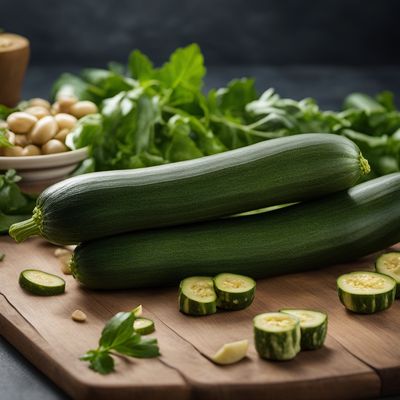
Ingredient
Angled luffas
The Versatile Vegetable: Angled Luffas
Angled luffas are long, slender vegetables with a ridged, green skin and a spongy white flesh. They have a mild, slightly sweet flavor and a crisp texture when cooked. The angled luffa's elongated shape and unique ridges make it a visually appealing ingredient in various dishes. It is commonly used in Asian cuisines, particularly in stir-fries, soups, and pickles.
Origins and history
Angled luffas have been cultivated in Asia for centuries and are believed to have originated in India or Southeast Asia. They have a long history of culinary use in Chinese, Thai, and Vietnamese cuisines. Angled luffas are highly valued for their versatility and nutritional benefits.
Nutritional information
Angled luffas are low in calories and a good source of dietary fiber, vitamin C, and potassium. They also contain small amounts of vitamin A and calcium. With only about 20 calories per 100 grams, angled luffas are a healthy addition to any diet.
Allergens
There are no known allergens associated with angled luffas.
How to select
When selecting angled luffas, look for firm, unblemished vegetables with bright green skin. Avoid luffas that are soft, discolored, or have wrinkled skin, as these are signs of spoilage. The ridges should be well-defined and the vegetable should feel heavy for its size. Fresh angled luffas should have a slightly shiny skin and a crisp texture.
Storage recommendations
To store angled luffas, place them in a perforated plastic bag and store them in the refrigerator. They can be kept for up to a week. Avoid washing the luffas before storing, as moisture can promote spoilage. If the luffas have been cut, wrap the cut ends in plastic wrap to prevent them from drying out.
How to produce
Angled luffas can be grown in home gardens or containers. They require a warm climate and well-drained soil. Plant the seeds in spring or early summer, and provide support for the vines to climb. Regular watering and fertilization will help the plants thrive. Harvest the luffas when they are about 6 to 8 inches long for the best flavor and texture.
Preparation tips
To prepare angled luffas, start by peeling off the tough outer skin with a vegetable peeler. Cut the luffas into desired shapes, such as slices or batons. They can be stir-fried, sautéed, or added to soups and stews. Angled luffas can also be pickled or used in salads for a refreshing crunch. To retain their crisp texture, cook them briefly until just tender. Avoid overcooking, as they can become mushy.
Culinary uses
Angled luffas are commonly used in stir-fries, soups, and pickles in Asian cuisines. They add a unique texture and mild flavor to dishes. They are also used in salads and can be pickled for a refreshing side dish.
Availability
Angled luffas are commonly available in Asian markets and grocery stores. They are cultivated in countries such as China, Thailand, Vietnam, and India.
More ingredients from this category

Snake gourds
Serpentine Delights

Summer squashes
Versatile Delights of Summer

Sopropos
The Versatile Gourd

Chayote fruits
The Versatile Chayote: A Hidden Gem in the Culinary World

Ivy gourds
The Versatile Ivy Gourd: A Hidden Gem in the Culinary World

Courgettes
The Versatile Zucchini

Pointed gourds
The Elegant Delicacy: Pointed Gourds

Bottle gourds
The Versatile Gourd: Unveiling the Secrets of Bottle Gourds
